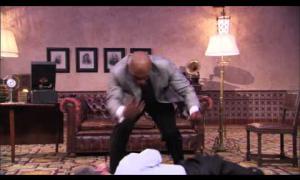The eyes have it: why eye contact is so important, and how to achieve it
January 31, 2009
Of all the factors that contribute to a successful presentation, your eye contact with the audience ranks first—more important than the words you choose, the way you organize your presentation, your speaking style or the visual aids you use.
This is the major conclusion of an academic study of participants in Communispond’s Executive Presentation Skills course.
The study, conducted by faculty at the School of Communication at the University of Akron, confirmed what successful speakers have known all along: Credibility is key, and the first step to getting it is looking your audience in the eye. And yet, some speakers scan the audience or look at the back wall, look at their feet or look upward to the ceiling. This quickly signals that they feel insecure. It detracts from their credibility and, with that, the audience’s willingness to take the action the speaker hopes to inspire.
So what’s to be done?
We advise speakers to make eye contact with one audience member for as long as it takes to express a thought or say a phrase, then move to another person to do the same. Research has shown that the audience members who sit near the person being addressed believe it is they who are being spoken to. Sustained periods of eye contact provide an additional payoff: The brain has less information to process than it would if the speaker was scanning; less information, less anxiety.
When you address a large audience, mentally segment the group into four or six parts and make certain you make eye contact with someone in each part during the presentation. It is best to begin making eye contact with someone in the back of the room so those in the rear are quickly drawn in. Audience members there can lose their concentration more quickly than others do, research has shown.
Another way to make sure you make eye contact: lose the script.
For large audiences, a teleprompter allows the speaker to follow a script and make eye contact with the audience at the same time. But for smaller audiences, reading from a script can detract from the presentation’s quality. The reading of prepared comments can make the audience feel the content is like day-old bread and nod off.
Of course, presenting without a script requires more rehearsal. Practice eye contact in front of family members, friends or co-workers who also can give you feedback on how well you are coming across. If others are not available, go to the length of practicing in front of hand-drawn pairs of eyes taped to chairs in front of you. During those rehearsals, also practice body movement to generate energy, and gesturing and voice changes to underscore important points.
(We cannot overestimate the value of rehearsals. The academic researchers studying the Communispond program evaluated the effectiveness of the students’ practice presentations at the beginning and end of the program. The researchers concluded that the overall quality of the presentations improved by an average of 42 percent between the first and last practice sessions and all 10 skills factors that were studied showed improvement.)
Through a few simple techniques and thorough rehearsal, you’ll make every talk more persuasive, moving your audience to your point of view and spurring them to action.
Kevin Daley is the founder of the communications consultancy Communispond Inc. and heads its executive coaching unit. Contact him at [email protected].

